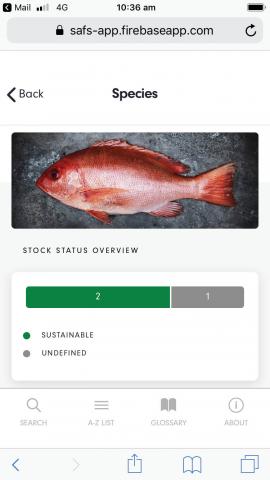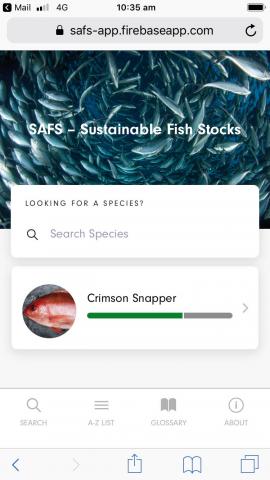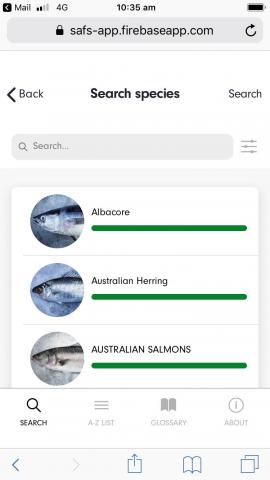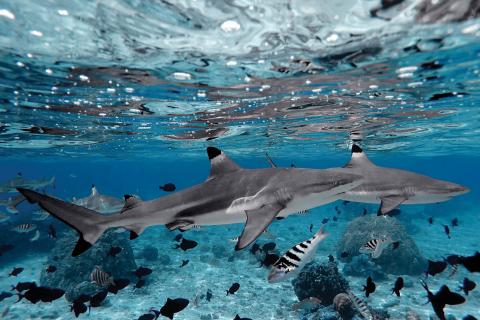New species and new ways of analysing data make the latest reports on Australian Fish stocks the most comprehensive yet – and available on your smartphone
By Annabel Boyer
Crimson Snapper.
The latest edition of the Status of Australian Fish Stocks (SAFS) reports is set to be launched at the Australian Bureau of Agricultural and Resource Economics and Sciences Outlook conference in Canberra on 5–6 March.
The reports provide a snapshot of how Australia’s fish stocks are tracking. The 2018 edition is the most comprehensive so far, bringing the number of species assessed from 83 to 120, including many of Australia’s favourite commercial and recreationally caught fish species.
The reports are a significant achievement for the fisheries science community. More than 100 fisheries scientists worked on the 120 species reports, which were then independently reviewed by a further 50 fisheries scientists.
Designed to inform the community, consumers and businesses of the sustainablity status of Australia’s fish populations, the reports can also assist in highlighting priorities for research and management. They provide a roadmap to ensure that sustainable stocks remain that way, and identify where action is needed to address species and stocks of concern.
Since the inaugural 2012 SAFS reports, each new edition has broadened the number of species covered. At 120 species and 406 stocks, the reports cover a majority of the wild harvested production volume across Australia.
Of the stocks in 2018, 254 stocks were assessed as sustainable, 23 as depleting, 18 as recovering, 29 as depleted and 28 as negligible. A further 54 were not able to be fully assessed and were classified as undefined. (See Table 2, Stocks assessed in 2018.)
Key changes
In developing the 2018 edition of the SAFS reports, the FRDC and the SAFS advisory working group conducted a review aimed at improving upon the 2016 edition of the reports. In this edition, minor changes have been made around stock status classification categories: the ‘environmentally limited’ classification has been removed, the ‘overfished’ classification has been replaced by ‘depleted’, and transitional stock categories are now ‘recovering’ and ‘depleting’.
Species and common names have also have changed; for example, Saucer Scallop (Ylistrum balloti) has been changed to Ballot’s Saucer Scallop.
To address these changes and develop a comparison tool across all editions of the reports, the FRDC engaged Andrew Penney, director of Pisces Australis. He has developed a method that uses the reports to produce trends over time. The report on developing the comparisons is available on the FRDC and SAFS websites (Research code 2017-100).
Tracking species recovery
From the outset in 2012, the aim of the SAFS reports has been to report on stock status trends over time. Fisheries and the marine environment are constantly changing. They are dynamic systems and the reports provide an insight into how species are faring and where management controls are needed, for example, to reduce catch or to protect fish during spawning.
Table 1 highlights cases where stocks have gone from depleted to recovering, or depleting to sustainable, as managers have put in place mechanisms such as reducing catch to support fish populations.
Table 1. Examples of stock status changes 2014-2018
| Species | 2014 Stock status |
2016 Stock status |
2018 Stock status |
| Blacklip Abalone | |||
| Victorian Central Zone Fishery | Depleted | Depleting | Depleting |
| New South Wales | Recovering | Sustainable | Depleting |
| Victorian Western Zone Fishery | Depleted | Sustainable | Sustainable |
| Tasmanian Eastern Zone Fishery | Recovering | Sustainable | Depleting |
| Blue Swimmer Crab | |||
| Cockburn Sound | Depleted | Depleted | Recovering |
| Shark Bay | Depleted | Recovering | Recovering |
| Gulf St Vincent | Recovering | Sustainable | Sustainable |
| Snapper | |||
| West coast | Recovering | Recovering | Recovering |
| Shark Bay inshore —Freycinet Estuary |
Recovering | Sustainable | Sustainable |
| Ballot Saucer Scallop | |||
| Ballot’s Saucer Scallop Abrolhos Islands and Mid-West Trawl Managed Fishery |
Depleted | Depleted | Sustainable |
| Shark Bay Scallop Managed Fishery |
Depleted | Recovering | Sustainable |
| Black Jewfish Northern Territory |
Depleted | Depleted | Recovering |
Broader impacts
While the reports provide a picture of the status of our fisheries stocks, the process of putting the reports together has gone a long way to harmonising how fisheries jurisdictions share knowledge and undertake stock assessments.
In writing the reports, many early-career scientists have also had the opportunity to work closely with and learn from senior scientists.
About 100 fisheries scientists from all jurisdictions work on the reports and for some species all jurisdictions contribute information.
In the future this knowledge could allow for a more cohesive management approach from management agencies.
SAFS app



Search capability on the SAFS app.
The SAFS reports are available online here, and also via a new smartphone app the FRDC has developed, available on the App Store and Google Play.
The app distils information from the SAFS reports into clear language. This will make it easier for the public and consumers to check on the sustainability status of different species, especially while they are buying seafood.
Table 2. Stocks assessed in 2018 (added 2012, 2014, 2016, 2018)
| No. stocks by type | |||||
| Year | No. species | No. stocks | Biological stock | Management unit | Jurisdictional stock |
| 2018 | 120 | 406 | 139 | 160 |
107 |
| No. stocks by status | |||||
| Sustainable | Negligible | Depleting | Recovering | Depleted | Undefined |
| 254 | 28 | 23 | 89 | 29 |
54 |
Additional sharks and rays reports

A ‘report card’ on 194 shark and ray species in Australian waters indicates that the majority are sustainable and in a healthy state. These included 180 shark and 14 shark-like ray species which comprise 199 stocks in total. Australia has one of the most diverse and distinctive shark and ray faunas in the world. A quarter of the 320 or so species occurring in Australian waters are endemic.
The shark report card project brought together all the information available from scattered and disparate sources to assess the status on individual species, and to provide a clear and concise overview of the state of Australia’s sharks and rays. While a considerable amount of information is available in peer-reviewed literature, a large amount of data is not formally published.
The report card found that, overall, Australia’s sharks and shark-like rays are in relatively good condition, with 124 stocks (79 per cent, excluding those classified as undefined) assessed as sustainable. Forty two stocks were assessed as undefined, meaning there was insufficient information to determine their status. Of the 199 stocks, only 18 (11.5 per cent) were assessed as depleted.
The report card highlights the species of concern that are either still in decline or depleted, and species for which management needs to be introduced to ensure stocks do not become depleted. The results of the assessment indicate that interactions with fisheries are sustainable for the large majority of species.
The report card on Australia’s sharks and rays can be accessed on the SAFS website.
37 new SAFS species
Australian Herring (Arripis georgianus)
Baldchin Groper (Choerodon rubescens)
Bastard Trumpeter (Latridopsis forsteri)
Bight Redfish (Centroberyx gerrardi)
Black Bream (Acanthopagrus butcheri)
Blue Threadfin (Eleutheronema tetradactylum)
Blue Warehou (Seriolella brama)
Bluespotted Emperor (Lethrinus punctulatus)
Bluespotted Flathead (Platycephalus caeruleopunctatus)
Bluethroat Wrasse (Notolabrus tetricus)
Brownlip Abalone (Haliotis rubra conicopora)
Eastern Sea Garfish (Hyporhamphus australis)
Elephantfish (Callorhinchus milii)
Estuary Cobbler (Cnidoglanis macrocephalus)
Grey Morwong (Nemadactylus douglasii)
Hapuku (Polyprion oxygeneios)
Jackass Morwong (Nemadactylus macropterus)
John Dory (Zeus faber)
Mahi Mahi (Coryphaena spp.)
Mangrove Jack (Lutjanus argentimaculatus)
Mirror Dory (Zenopsis nebulosus)
Ocean Jacket (Nelusetta ayraudi)
Ocean Perch (Helicolenus barathri & H. percoides)
Pearl Perch (Glaucosoma scapulare)
Periwinkle (Trochidae, Margaritidae, Solariellidae, & Tegulidae spp.)
Rankin Cod (Epinephelus multinotatus)
Redfish (Centroberyx affinis)
Ribaldo (Mora moro)
Roe’s Abalone (Haliotis roei)
Royal Red Prawn (Haliporoides sibogae)
Sawsharks (Pristiophorus spp.)
School Mackerel (Scomberomorus queenslandicus)
Silver Warehou (Seriolella punctata)
Spangled Emperor (Lethrinus nebulosus)
White Teatfish (Sea Cucumber) (Holothuria fuscogilva)
Yellowfin Whiting (Sillago schomburgkii)
Yellowtail Scad (Trachurus novaezelandiae)
FRDC Research Code: 2017-100
More information
Carolyn Stewardson
carolyn.stewardson@frdc.com.





